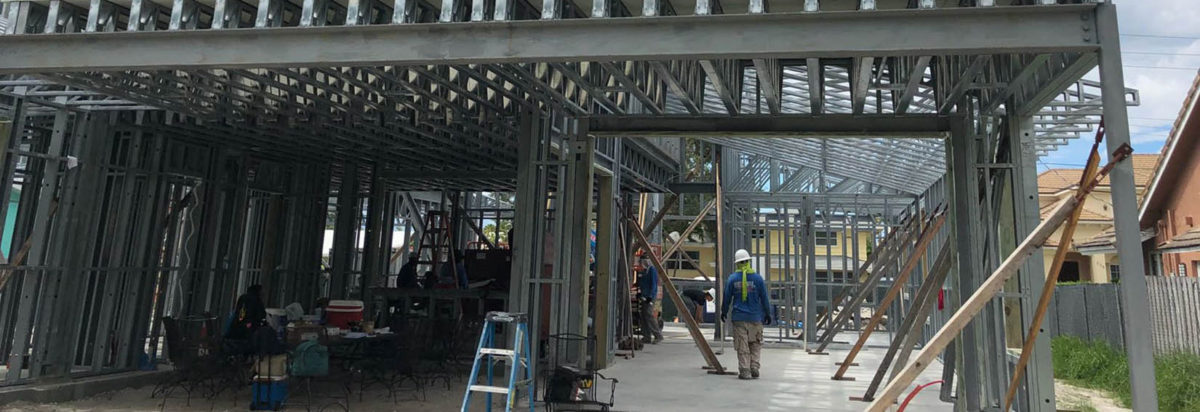Light Gauge Steel Framing vs. Wood Framing
Using the best framing material for building homes is essential for contractors. A home or building is a big investment that requires a lot of planning to avoid any regrets. Doing some research in advance is essential in helping you decide between light gauge steel or lumber for your next construction project. Keeping all of these different pros/cons in mind can help you decide which is the best option for your situation.
Light Gauge Steel or Lumber
Light gauge steel framing (LGS) is gaining in popularity as an alternative to using lumber framing. LGS is powerful and durable while also being flexible in design. LGS is a much better long-term investment compared to lumber construction.
Here is an overview of the differences between using a steel frame vs. wood frame materials in construction.
Durability
Wood can easily absorb and release moisture, which makes it perform well in high-humidity climates. However, wood can suffer significant damage if it soaks in water for a long time. Mold can eventually form and cause the wood framing to rot. Termites can also create massive damage once they get inside a home. According to the United States Department of Agriculture (USDA), termite damage causes up to $2 billion worth of damage each year. Despite these various weaknesses, wood framing can last a long time with proper maintenance.
Steel framing offers superior durability compared to wood materials. For example, you don’t have to worry about mold or rot with steel framing. Termites also can’t cause any damage to steel construction, which will give you peace of mind. Wood can eventually begin to warp or shrink due to moisture, while steel will always remain the same because it’s non-porous. However, using a protective coating for steel framing is vital to avoid corrosion due to exposure to the outside elements.
Fire Resistance
Pine, spruce, and fir trees are often used in wood frame construction due to them being cheap and lightweight. These building materials are easy to handle during the construction process, which can improve efficiency. However, one of the main drawbacks of wood construction is the risk of fire. Softwood can quickly ignite and spread much faster compared to heavy hardwoods that were once popular in buildings. Incorporating fire-resistant materials, installing a sprinkler system, and creating adequate exit routes are essential aspects of wood construction. An important safety feature of LGS is that it acts as a barrier against the spread of flames.
Flood Damage
Taking flood-resistant measures for wood construction is important due to its potential for developing mold, rotting, shrinking, or warping if it’s soaked in water for a lengthy time. One way to combat these issues is to apply water-repellent paint to the wood frame. Spraying closed-cell foam within the stud bays or using XPS insulation boards is also helpful in decreasing flood damage.
Galvanized steel uses a protective zinc coating that provides a moisture barrier against water damage. Using this coating provides steel framing a significant advantage over wood construction, making it nearly invincible against flood conditions. Applying anti-corrosion coating is also beneficial to extend its longevity further, as galvanized steel may eventually lose its zinc coating in harsh environments.
Seismic Performance
Building solid structures is especially important in areas prone to earthquakes. Wood is a fairly sturdy material during normal circumstances, but it needs additional reinforcement to prevent a collapse amidst seismic activity. Building additional support will increase construction costs, but it’s always well worth the cost in many regions of the country. Lateral bracing is often effective at providing support to handle the additional horizontal loads caused by earthquakes.
An added benefit of using LGS framing is that it offers additional flexibility in providing lateral load resistance. Engineers can choose from various alternatives, whether using steel sheathing, plywood, or flat-strap X-bracing for additional support. On the other hand, wood structures are often limited to bracing options on shear walls. Besides offering protection against earthquakes, the strong foundation of steel provides you additional protection against severe storms and strong winds.
Building Costs
With the spike in lumber costs, you will find that metal or light gauge steel is cheaper to use than wood. In addition to the cost savings, you will also find that steel frame home have a much lower lifetime cost associated with its near-zero maintenance. If you ever decide to sell or tear down your building or house, the metal can be 100% salvaged, recycled and sold.
Potential Insurance Savings
Using steel for home construction can also help reduce your insurance premium compared to wood framing. These cost savings are often significant, as it’s a good idea to receive multiple quotes from insurance providers to help you find the best coverage at the right price. Adding different elements to your design can also lower your insurance, such as installing a fire sprinkler system or fire-resistant insulation.
Closing Thoughts
Comparing steel versus wood framing is important in helping you make the best decision for your next building project. Steel framing offers a variety of benefits, and it continues to grow in popularity. It’s important to keep all of these various factors in mind to help you choose which material is the best option for your next home construction building project.
If you have any questions, or want to learn more about using light gauge steel for your next project, please contact us at (863) 623-3021 or email info@wallsupusa.com for additional information.




